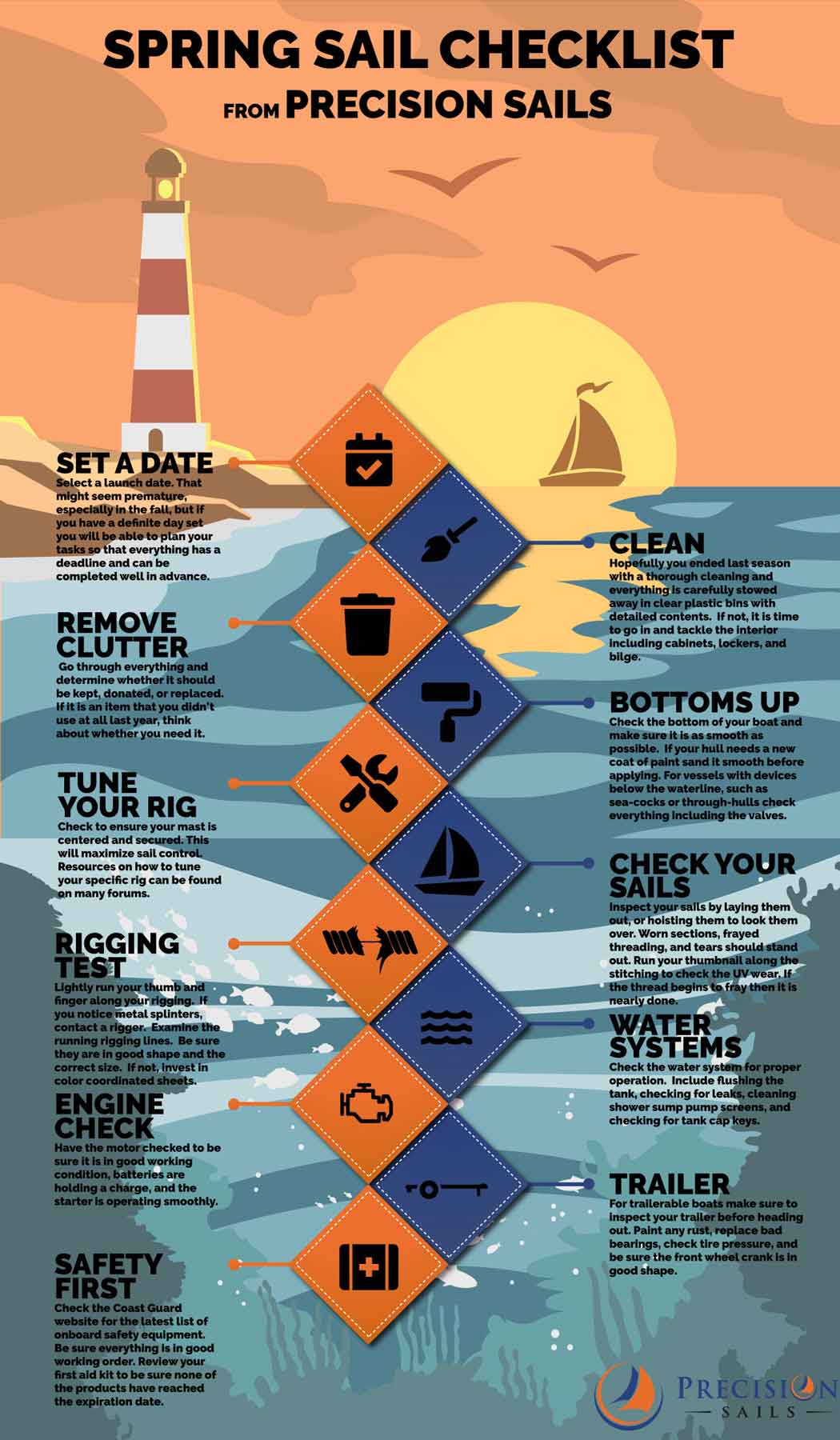Get Your Sailboat Ready For Spring – Checklist And Infographic
The sailing season is almost here! But with all the joy that comes with sailing comes the monotonous task of prepping the boat for the season. Unwrapping the boat, cleaning the hull, checking your rigging… there is so much to do, and for most casual cruisers, not much time. The list and infographic below are great guides preparing for the spring sailing season. Download the graphic, or share it with a friend!
Spring Sail Infographic:
Spring Sail Checklist:
If you have prepared ahead of time you may have already cleaned the bottom, wiped down the interior, and emptied out your lockers and equipment. However, this list might have one or two things that will help you out.
- Set a date -Select a launch date. That might seem premature, especially in the fall, but if you have a definite day set you will be able to plan your tasks so that everything has a deadline and can be completed well in advance.
- Clean – Hopefully you ended last season with a thorough cleaning and everything is carefully stowed away in clear plastic bins with detailed contents. If not, it is time to go in and tackle the interior including cabinets, lockers, and bilge. Don’t forget to wipe down the inside and leave doors open for airflow to ensure proper drying. Aside from scrubbing the deck and interior, it is also a good idea to inspect and clean your sails. Luckily we have already written a blog post on cleaning your sails. We have also put a guide together on maintaining your sails to increase their lifespan. Check them out.
- Eliminate the unnecessary – Go through everything in those storage boxes, or during your cleaning process. Determine whether it should be kept, donated, or replaced. If it is an item that you didn’t use at all last year, think about whether you need it. Get a second opinion if necessary. And don’t forget the importance of recycling. While you might not need a specific tool or item someone else might need it. Having a list of everything onboard your boat can be helpful, especially if you plan on coastal cruising or offshore sailing.
- Bottoms Up – Check the bottom of your boat and make sure it is as smooth as possible. This is easily done when on the hard but a diver can be used to check the condition of your bottom paint while still in the water. If your hull needs to be cleaned while in the water make sure to take some precautions. Have someone else on board to help in case of an emergency. Snorkel or Dive under the boat and scrub the hull using a stiff brush. Be careful, some mites and bugs dislodged from the hull can bite and give you swimmers itch. Wearing a wet suit or drysuit and hosing yourself down immediately afterward are great ways of preventing this discomfort. If your hull needs a new coat of paint sand it smooth, mark the waterline and drape the sides of the hull, apply a new coat paint, and wash and wax the sides. Clean and wax the deck where required. For vessels with devices below the waterline, such as sea-cocks or through-hulls check everything including the valves and replace seals as necessary.
- Rig – Be sure the rig is centered and tuned. This will maximize sail control. This is often done by attaching a scale to the main halyard shackle or any halyard centered on the masthead and applying the appropriate amount of pressure. Guides for tuning your specific rig especially can be found on many cruising forums and club websites.
- Hoist the sail – Inspect your sail by laying them out, or hoisting them to look them over. Worn sections, frayed threading, and tears will stand out. To check the integrity of your stitching perform the thumbnail test. Simply run your thumbnail along the stitching to check its UV wear. If the thread begins to fray it might be time to replace the sail. Once you have inspected your sail head out in light to medium conditions. Take photos of your sails for reference and make notes about any conditions you see. This will serve as a good record if the jib or genoa starts to cup in on the leech, or if the draft positions itself too far aft. We have also made a great guide for inspecting the condition of your sails, which you can read here. Getting new sails is a super easy process, just click here to request a quote and talk to a sail consultant.
- Rigging – The metal rigging should be inspected seasonally to ensure it is strong and in good condition. Lightly run your thumb and forefinger along the wires. If you notice metal splinters, contact a rigger. Examine the running rigging lines. Be sure they are in good shape (no fraying) and the correct size. If not, invest in color-coordinated control lines.
- Motor – Have the motor checked to be sure it is in good working condition, batteries are holding a charge, the starter is operating smoothly, and don’t forget to change the oil. If your handy (as most cruisers are) you can do this yourself, otherwise reach out to a marine mechanic or a friend to take a look.
- Water System – Check the water system for proper operation. Especially if you are planning any coastal cruising or offshore passages. Include flushing the tank, checking for leaks, cleaning shower sump pump screens, and checking for tank cap keys.
- Trailer – For trailerable boats make sure to inspect your trailer before heading out. Paint any rust, replace bad bearings, check tire pressure, and be sure the front wheel crank is in good shape.
- Safety First – Check over your safety, first aid, and communication equipment and keep it up to date. The local Coast Guard website should list the required onboard safety equipment. Be sure everything is in good working order. Review your first aid kit to be sure none of the products have reached the expiration date.



